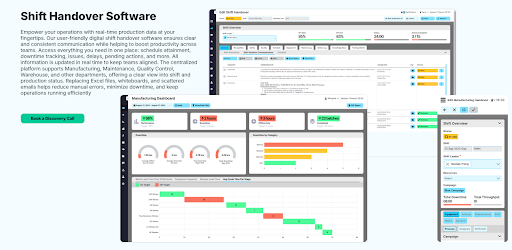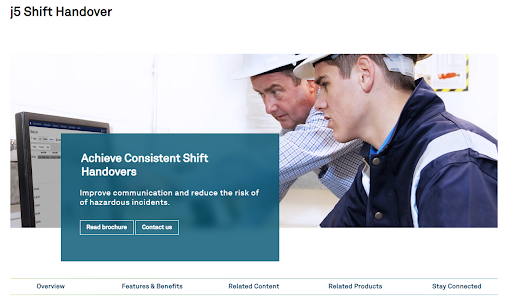

Shift handovers are a critical part of daily operations in industries like manufacturing, energy, and pharmaceuticals. When information is lost or miscommunicated during these transitions, the consequences can include downtime, safety incidents, compliance risks, and reduced productivity.
As industrial environments become more complex and data-driven, organizations are replacing paper logbooks and spreadsheets with digital shift handover systems. The best software solutions do more than just record events, they enable consistent communication, improve traceability, and help teams make better decisions based on real-time operational data.
This expert comparison highlights the top shift handover platforms available in 2025. It provides an overview of how each tool supports operational continuity, safety, compliance, and performance improvement, helping leaders select the right solution based on their unique needs.

EviView is a shift handover solution built specifically for pharmaceutical and manufacturing teams that require strict compliance, full traceability, and data-driven insights. It combines structured digital shift logging with real-time visibility into operational data. Managers and frontline teams can capture events, issues, and KPIs in one centralized system that supports decision-making and continuous improvement.
Unlike generic logbook tools, EviView is designed for regulated environments, with audit-ready records and customizable workflows that align with GMP and other compliance frameworks. It also integrates with existing ERP and MES systems to create a unified operational view. For teams seeking operational excellence, EviView offers more than just documentation, it drives smarter, safer, and faster shift transitions.

Hexagon’s J5 Shift Handover software offers a web-based alternative to spreadsheets and paper-based logbooks. It provides configurable templates and supports integration with control room systems. The platform is designed for industrial operations where structured communication is essential. While it effectively digitizes handovers, it focuses more on standardization than real-time analytics or production improvement.

Intellipermit includes shift handover as part of its permit-to-work system. The platform emphasizes safety and operational risk, helping supervisors transfer job and hazard information across shifts. It is useful in environments where permits and safe work practices are closely tied. The handover feature is functional, but secondary to the system’s core focus on work authorization.

Innovapptive offers a shift handover solution within its connected worker platform. It is designed for asset-intensive operations and integrates with SAP, allowing field teams to document shift activity using mobile devices. The platform supports visibility into open tasks and ongoing work. It is best suited for organizations already invested in SAP workflows, rather than regulated manufacturing environments.
Sphera includes shift handover capabilities as part of its Operations Logbook, which sits within its process safety suite. It enables teams to record operational events and updates in a centralized digital log. The system supports safe transitions in high-risk industrial settings. Its primary focus remains on safety and compliance rather than continuous operational improvement.

Evotix offers a shift handover feature as part of its broader EHS software. It supports safe and structured communication between outgoing and incoming teams, especially for documenting safety issues or unresolved incidents. The tool fits well in organizations focused on health and safety. It is not built for manufacturing analytics or performance optimization.
When selecting a shift handover platform, the goal isn’t just to digitize logbooks. The right solution should reduce miscommunication, improve traceability, and support operational consistency across shifts. Below are the key factors to consider when evaluating options.
Shift handover processes are tightly linked to compliance in industries like pharmaceutical manufacturing, energy, and food production. Make sure the software can align with your specific regulatory standards, whether that includes GMP, FDA, ISO, or OSHA. It should offer audit-ready logs, timestamped entries, and secure user access controls to support inspections and internal audits.
Your team needs immediate access to up-to-date shift information to make informed decisions. Look for platforms that allow real-time logging, visibility across departments, and clear handoff of unresolved issues or tasks. This helps eliminate communication gaps and reduces the risk of errors between shifts.
If the software is too complex, adoption will be a challenge. The solution should be simple enough for operators, technicians, and supervisors to use consistently. Clear layouts, minimal manual input, and mobile access are important features that increase daily usability across teams.
A shift handover tool should connect to your broader operational systems like ERP, MES, or maintenance software. Integration ensures that shift data flows seamlessly into other critical workflows, avoiding duplication and maintaining data accuracy across platforms.
Beyond documenting each shift, the software should help you identify patterns over time. Look for features that allow you to review historical handovers, analyze common equipment failures, or track unresolved issues. This kind of visibility is essential for continuous improvement and root cause analysis.
Your handover process is unique to your operation. Choose a platform that lets you configure categories, terminology, approval steps, and user roles. A flexible system will adapt to your workflows rather than forcing your team to adapt to the software.
Choosing a shift handover solution is no longer just about replacing paper logs. It’s about selecting a tool that supports your team’s ability to communicate effectively, operate safely, and continuously improve. The software options available today vary in focus — some prioritize safety, others focus on asset management — but the most effective platforms combine structured handovers with actionable data and seamless integration into your existing systems.
As operations scale and compliance demands increase, the value of a robust, configurable, and user-friendly shift handover system becomes clear. Whether you’re in manufacturing, pharmaceuticals, or heavy industry, the ability to document, track, and analyze shift activity is essential to operational excellence.
This article has outlined what to look for in a shift handover solution, from real-time visibility and compliance readiness to ease of use and system integration. If your operations require structured communication, data traceability, and continuous improvement across every shift, now is the time to take the next step.
Book a demo with EviView to see how a purpose-built shift handover platform can help your team streamline handovers, reduce risk, and improve decision-making with operational data you can trust.
Written By: Karol Dabrowski
Share: